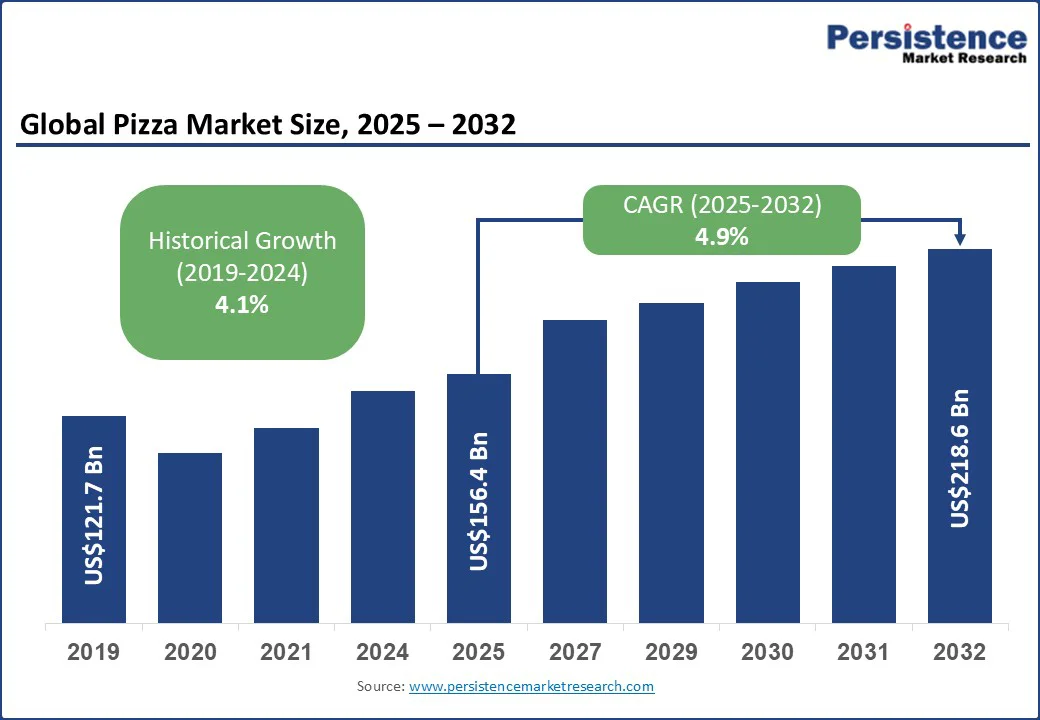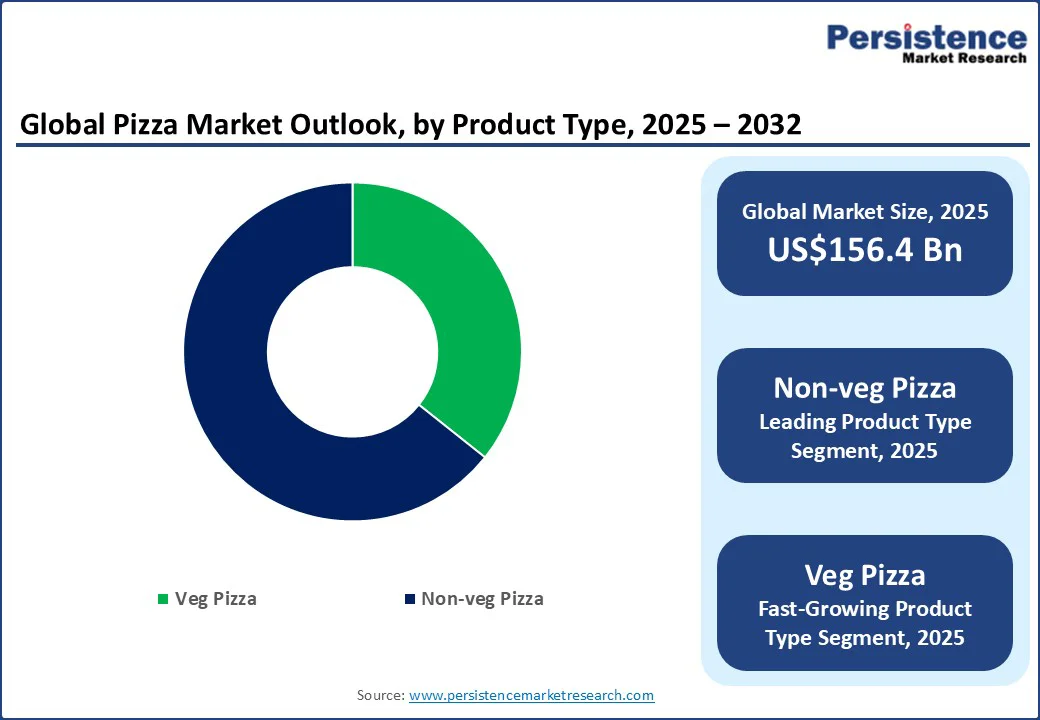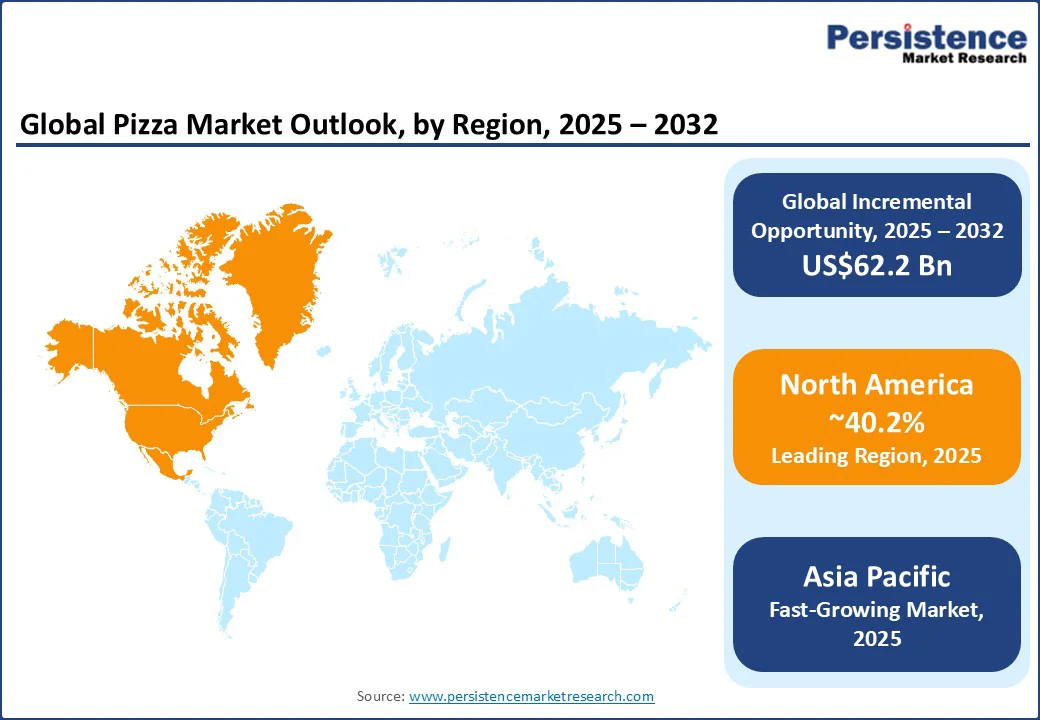ID: PMRREP35653| 180 Pages | 24 Sep 2025 | Format: PDF, Excel, PPT* | Food and Beverages

The global pizza market size is likely to be valued at US$156.4 Bn in 2025 and is estimated to reach US$218.6 Bn in 2032, growing at a CAGR of 4.9% during the forecast period 2025-2032, driven by the rising popularity of quick-service restaurant chains, ongoing developments in flavors and crusts, and evolving distribution channels that prioritize convenience and speed. High consumer demand, changing food preferences, and continual adaptation by leading players underpin growth across regional and segment categories.
Key Industry Highlights

| Key Insights | Details |
|---|---|
|
Pizza Market Size (2025E) |
US$156.4 Bn |
|
Market Value Forecast (2032F) |
US$218.6 Bn |
|
Projected Growth (CAGR 2025 to 2032) |
4.9% |
|
Historical Market Growth (CAGR 2019 to 2024) |
4.1% |
Urban migration and an increasingly mobile workforce propel demand for convenient meal solutions, with pizza as a preferred choice. In 2025, urban households contributed over 65% to QSR pizza purchases worldwide, supported by demographic studies from the UN Food and Agriculture Organization. This structural shift expands addressable market segments and sustains above-trend growth for premium and value-based ranges.
Rapid urban migration and the expansion of an increasingly mobile workforce are changing the global food consumption patterns. As people in metropolitan areas face long working hours, short meal times, and dual-income households, the preference for quick dining solutions has grown. Pizza, being versatile, affordable, and widely customizable, has emerged as a go-to option for this demographic.
The adoption of mobile ordering platforms and third-party delivery logistics creates new opportunities for pizza companies to reach broad audiences. In 2025, over 55% of global pizza sales occurred through online channels, as reported by industry sources and research studies. AI-powered menus, integrated digital payments, and automated delivery enhance both efficiency and customer loyalty.
Beyond ordering, technological development is redefining the entire value chain. AI-based menu customization allows brands to analyze individual preferences and purchasing behavior, creating recommendations to increase average order values. The integration of digital payment systems improves convenience and security, while automation in delivery lowers operational costs. These developments not only improve efficiency but also refine customer satisfaction.
The introduction of regional flavors and crust innovations allows pizza brands to customize products for diverse consumer groups. According to a recent report, nearly 36% of sales growth in Asia Pacific and 29% in Europe is attributed to the Westernization of food habits and continual menu adaptation. These efforts expand the market reach to new geographies and cultural segments, thereby boosting market share and margins for multinational chains.
The growing global acceptance of diverse cuisines has created unique opportunities for pizza brands to position themselves as both international and locally relevant. While classic Margherita or Pepperoni continues to dominate globally, the ability of brands to integrate regional flavors has proven instrumental in winning over diverse consumer bases. Crust development has also become a differentiator, with options such as cheese-stuffed edges, thin-crust, and even rice- or cauliflower-based bases catering to varying cultural preferences and dietary requirements.
Volatility in ingredient prices, transport, and labor costs impacts margins for pizza operators globally. Cheese, wheat, and tomato prices rose by 7 to 11% in 2025, per the Food and Agriculture Organization (FAO) and industry reports, causing pressure on input cost management and pricing strategies. Dependence on global suppliers exposes pizza companies to cross-border risks and inflation shocks.
Compliance with food safety labeling, dietary standards, and environmental policies introduces complexity in operations. The World Health Organization (WHO) and local regulatory agencies have implemented new sodium and trans-fat guidelines, affecting product formulations and supply chains. These barriers require ongoing investment in research and development and compliance, and raise costs for both large and small pizza businesses.
Asia Pacific, Latin America, and parts of Africa present substantial opportunities, with pizza adoption rates expected to rise at a 6 to 8% CAGR from 2025 to 2032. According to a recent study, the total incremental market opportunity exceeds US$30 Bn for regional expansion, especially for global QSR brands. Localized flavor development and franchising models accelerate entry and scalability.
Consumer demand for gluten-free, low-carb, plant-based, and organic pizza options fuels growth in premium categories. Recent reports forecast the health-focused pizza sub-segment to surge at about 6.5% CAGR to 2032, with vegan and specialty crusts outpacing traditional variants. Innovation in ingredient sourcing and labeling also enhances brand appeal to health-conscious and younger demographics.
Eco-friendly packaging, carbon-neutral delivery, and digital procurement provide differentiation, especially in Europe and key U.S. metro markets. A new survey reports that approximately 27% of consumers consider environmental impact when purchasing pizza, and the implementation of sustainable practices leads to loyalty and regulatory benefits.
Non-veg pizza is expected to capture approximately 64.3% of the market share in 2025, dominating consumer preferences worldwide, especially in North America and Asia Pacific. Non-veg pizza volume is projected to maintain leadership due to diverse topping combinations and powerful brand loyalty among key demographics.
Veg pizza sales are predicted to rise at a CAGR of 5.8% in the forecast period, as demand surges for low-calorie and plant-based formulations, primarily in Europe and India, as per a few studies. Rising health awareness and regulatory incentives for plant-based food also drive product development and retail penetration in these markets.
Thick crust pizzas are anticipated to account for nearly 38.5% of the market share in 2025. These are favored for their substantial size and value proposition in group and family dining. North America-based chains lead this category, embracing traditional recipes and promotional offers to anchor their menus.
Stuffed crust is predicted to expand at about a 6.2% CAGR from 2025 to 2032, driven by indulgence trends and unique cheese or flavor fillings. QSR menu engineering and consumer upgrade incentives further support segment acceleration, mainly in competitive U.S. and Asia Pacific regions.
Quick-service restaurants (QSRs) are projected to dominate with approximately 63.2% of the market share in 2025. Their focus on speed, customer convenience, and marketing effectiveness helps them maintain leadership in urban and suburban markets. Franchising, app-based orders, and a global footprint further reinforce QSR dominance.
Digital and online sales channels are projected to expand at over 7% CAGR through 2032, attributed to mobile apps, third-party aggregators, and proprietary e-commerce solutions. Integrating AI into customer targeting and loyalty further raises segment performance.

North America is projected to dominate, representing around 40.2% of the market share in 2025. The U.S. alone exceeds US$50 Bn, underpinned by deep cultural affinity, strong QSR networks, and relentless innovation such as drone/robotic deliveries, AI-based menu customization.
Regulatory frameworks ensure food safety, labeling transparency, and environmental standards, while sustained investment flows support technological upgrades and store modernizations. Competitive intensity remains high with fragmented local and regional players vying for market share through differentiated menu engineering, loyalty programs, and brand-building campaigns.
Asia Pacific is anticipated to account for around 23.8% of the global market share in 2025 and demonstrates the fastest regional CAGR at 8.1% from 2025 to 2032. Key markets such as China (US$15.6 Bn, CAGR 6.5%), Japan (US$4.8 Bn, CAGR 5.5%), and India (US$4.1 Bn, CAGR 8.8%) are augmented by Westernization, ongoing urbanization, and a rising middle-class appetite for convenience and novel flavors.
Regulatory support for food safety and investments in local sourcing foster growth, with international QSR chains constantly expanding their store counts and digital ordering capabilities. Competitive landscape features franchising partnerships and joint ventures, enabling fast market entry and adaptation to regional consumer preferences.
Europe’s market for pizza is pushed by diversity in product lines, reflecting both traditional Italian heritage and the influence of global chains. Key countries such as Germany, the U.K., France, and Spain support strong frozen pizza markets and growing QSR presence, valued at over US$35 Bn in 2025 with a projected CAGR of 3.8%.
Regulatory harmonization on ingredients, health claims, and sustainability guides new product launches and supply chain transformation. Investment trends favor premiumization (gourmet/artisanal pizzas) and digital ordering platforms, accelerating penetration in convenience-focused segments and eco-savvy demographics.

The global pizza market is moderately fragmented worldwide but highly consolidated regionally, especially in North America, where the top five brands, including Domino’s, Pizza Hut, Papa John’s, Little Caesars, and MOD Pizza, represent nearly 55% of the U.S. market share in 2025. QSRs maintain a competitive advantage through extensive retail networks, proprietary order platforms, and unique promotional campaigns, while artisan and boutique outlets diversify product development.
Market leaders prioritize innovation, cost leadership, rapid expansion, and multi-channel engagement. Key differentiators include AI-backed customization, sustainability focus, and hyperlocal menu adaptation. The rise of subscription models, direct-to-consumer platforms, and hybrid delivery models signals ongoing business evolution.
The pizza market is projected to reach US$156.4 Bn in 2025.
The growth of online food delivery platforms and the globalization of food culture are the key market drivers.
The pizza market is poised to witness a CAGR of 4.9% from 2025 to 2032.
Partnerships with delivery aggregators and the development of gluten-free pizzas are the key market opportunities.
Domino’s Pizza, Pizza Hut, and Papa John’s International are among the key players in the pizza market.
| Report Attribute | Details |
|---|---|
|
Historical Data/Actuals |
2019 - 2024 |
|
Forecast Period |
2025 - 2032 |
|
Market Analysis |
Value: US$ Bn |
|
Geographical Coverage |
|
|
Segmental Coverage |
|
|
Competitive Analysis |
|
|
Report Highlights |
|
By Product Type
By Crust Type
By Distribution Channel
By Region
Delivery Timelines
For more information on this report and its delivery timelines please get in touch with our sales team.
About Author